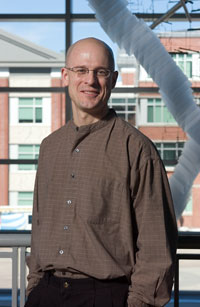  |
| HOME | THIS ISSUE | CALENDAR | GRANTS | BACK ISSUES | < BACK | NEXT > |
Economist’s work on land use policy looks at sprawl, preservation of landby Karen Singer - March 19, 2007 | ||||
| Recent surveys of rural residents indicate their increasing concern about development and an eagerness to retain the essential characteristics of their surroundings. The problem is that few know how to go about doing it. “There are many different tools that people can use to protect lands; it’s just a question of combining the tools properly,” says Robert Johnston, an associate professor in the agricultural and resource economics department at the Avery Point campus. A new book edited by Johnston and Stephen K. Swallow, Economics and Contemporary Land Use Policy: Development and Conservation at the Rural/Urban Fringe (Resources for the Future, 2006), stresses the role of “both spatial and economic-ecological interactions in contemporary land use” and the importance of a “practical, policy-oriented perspective.” It delves into such issues as the role of economics in land use policy; forecasting development; managing land conversion; and exploring the relationship between land use, property values, and local taxes. “We’re looking at how economics can help us make better policy decisions when faced with these pressures,” Johnston says. Economics and Contemporary Land Use Policy is designed to be broadly focused, but most of the emphasis is on the Northeast United States, where sprawl is more of an issue than other places, he adds. The book dovetails with the professor’s research, which focuses on the values Connecticut residents place on preservation of various types of undeveloped land in their community and around the state, including farm, forest, and open space. Johnston says he is concerned about the implications of these values for the preservation policies that are most appropriate, and about the state’s ability to maximize the benefits of preservation for residents. He also assesses the economic benefits and costs, broadly defined, of development and conservation at the rural-urban fringe. Citing data from the National Agricultural Statistics Service Census of Agriculture, Johnston notes that Connecticut lost 700 farms between 1997 and 2002. During that time, 12.8 percent of Connecticut farmland disappeared – the largest percentage loss of any state in the United States. The greatest percentage of farmland losses occurred in Middlesex County (-22 percent) and New London County (-23 percent). The greatest acreage losses occurred in Litchfield County (-93,569 acres), Windham County (-61,124 acres) and Hartford County (-50,192 acres). “Land use and preservation is a huge issue … involving economic forces, like profit motive among developers and demand among consumers,” Johnston says . “It also represents a case of market failure, where the actions of the free market do not provide outcomes that are beneficial to society. For example, the free market tends to under-provide things such as nice scenic views, ecological quality, and the rural sense of place that is valued by many residents.
“Rural quality of life offers real benefits to residents, and the market doesn’t reflect the losses in quality of life that can accompany the loss of rural land use,” he adds. “My interest, as an economist, is what we can do about it.” Surveys that Johnston has pioneered help characterize the type of land preservation Connecticut residents prefer. “My work develops new and improved ways to establish how and why people value farmland,” he says. His research shows the reasons people value farmland preservation also vary greatly, depending on factors such as where they live, who they are, and how accessible the land is. “Typically, when people vote on a bond act, they don’t know what kind of land they’re going to get and what effect it will have on their taxes,” he says. “We lay out these critical details [in choice-based studies], and by looking at how they vote for these specific preservation options, we can determine what aspects of preservation are most valued.” Such information, he argues, can help community leaders set priorities and better allocate funds for preserving local land. “Towns should realize these lands are valuable,” Johnston says. “They need to figure out where they want to go. Do they want more development? Do they want more sprawl? How can they preserve the land they want to preserve? “These are hard choices and in some cases might mean more bond issues or more taxes … but if people are serious about keeping their rural character, they are choices that have to be faced.” Research that Johnston conducted in Rhode Island before coming to Connecticut, demonstrated that tax reductions on farmland and forest space were a cost-effective means of land preservation. That work led to the passage of a law which, he says, “enabled towns to continue these differential assessments … and maintain larger areas of farm and forest land.” The work also led to an award in 1999 from the Rhode Island Rural Lands Coalition. “Everybody likes to talk about the way an area used to be, and feel nostalgic after the fact,” Johnston says. “What we’re trying to do is get people to be proactive.” |
| ADVANCE HOME UCONN HOME |

